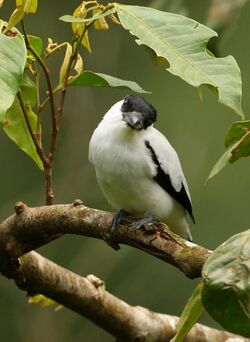Biology:Black-crowned tityra
| Black-crowned tityra | |
|---|---|

| |
| Male, Rio Silanche Reserve, NW Ecuador | |
| Scientific classification | |
| Domain: | Eukaryota |
| Kingdom: | Animalia |
| Phylum: | Chordata |
| Class: | Aves |
| Order: | Passeriformes |
| Family: | Tityridae |
| Genus: | Tityra |
| Species: | T. inquisitor
|
| Binomial name | |
| Tityra inquisitor (Lichtenstein, MHC, 1823)
| |

| |
| Synonyms | |
|
Erator inquisitor | |
The black-crowned tityra (Tityra inquisitor) is a medium-sized passerine bird. It has traditionally been placed in the cotinga or the tyrant flycatcher family, but evidence strongly suggest it is better placed in Tityridae.
It is found in Argentina , Belize, Bolivia, Brazil , Colombia, Costa Rica, Ecuador, French Guiana, Guatemala, Guyana, Honduras, Mexico, Nicaragua, Panama, Paraguay, Peru, Suriname, Trinidad and Tobago, and Venezuela. Its natural habitats are subtropical or tropical moist lowland forests and heavily degraded former forest.
Taxonomy
Subspecies
- Tityra inquisitor inquisitor: Tropical southeast Brazil (s Piauí) to east Paraguay and northeast Argentina
- Tityra inquisitor fraserii: Tropical southeast Mexico (San Luis Potosí) to central Panama
- Tityra inquisitor albitorques: Tropical east Panama to northwest Bolivia and west Amazonian Brazil
- Tityra inquisitor buckleyi: Tropical southeast Colombia (Caquetá) and east Ecuador (Napo-Pastaza)
- Tityra inquisitor erythrogenys: Tropical east Colombia to Venezuela, the Guianas and north Brazil
- Tityra inquisitor pelzelni: Tropical northeast Bolivia, Mato Grosso and Brazil south of the Amazon
The syntypes of Psaris fraserii Kaup (Proc. Zool. Soc. London, pt. 19. ,1851 (1852), p.47. pl. 37-38), an adult male and female, are held in the vertebrate zoology collection of National Museums Liverpool at World Museum, with accession number NML-VZ D1868 and NML-VZ D1868a. The specimen came to the Liverpool national collection via the 13th Earl of Derby’s collection which was bequeathed to the people of Liverpool in 1851.[3]
References
- ↑ BirdLife International (2016). "Tityra inquisitor". IUCN Red List of Threatened Species 2016: e.T22700692A93792825. doi:10.2305/IUCN.UK.2016-3.RLTS.T22700692A93792825.en. https://www.iucnredlist.org/species/22700692/93792825. Retrieved 12 November 2021.
- ↑ "Tityra inquisitor (Black-crowned Tityra) - Avibase". https://avibase.bsc-eoc.org/species.jsp?avibaseid=85750F2B.
- ↑ R. Wagstaffe (1978-12-01). Type Specimens of Birds in the Merseyside County Museums (formerly City of Liverpool Museums). http://archive.org/details/type-specimens-of-birds-in-the-merseyside-county-museums-wagstaffe.
Further reading
- Skutch, Alexander F. (1969). "Black-crowned tityra". Life Histories of Central American Birds III: Families Cotingidae, Pipridae, Formicariidae, Furnariidae, Dendrocolaptidae, and Picidae. Pacific Coast Avifauna, Number 35. Berkeley, California: Cooper Ornithological Society. pp. 10–19. https://sora.unm.edu/sites/default/files/journals/pca/pca_035.pdf#page=10.
Wikidata ☰ Q1305621 entry
 |



